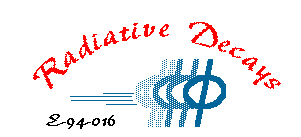

Radphi Video Conference 12/03/02
December 3, 2002
University of Connecticut
Storrs, CT
Present: C. Steffen, R. Jones, M. Kornicer, D. Steiner, S. Teige,
D. Armstrong, E. Smith, P. Rubin, D. Krop.
UI report:
- problem at high mass: large error bars and excess yield.
They are now generating a new set of MC to understand acceptance
up there. Consistency tests: vanishing of odd moments in pi0pi0,
this is now being understood. He (Dan) is now doing the PWA fit,
including up to l=4, m=+-2,+-1,0 and both reflectivities.
W+M report:
-
www.physics.wm.edu/~steiner/radphi
- Dan has timed in the tagger, bgv and bsd relative to cpv28.
He saw some odd features in the tag L16 - RJ said the peaks were
due to double-pulsing. RJ will write up a web page on the alignment
calibration and map entries.
- also showed analysis results. His web page shows some 4gamma mass
plots. On his 6gamma mass plots he has a beautiful eta->3pi0 signal.
His 5gamma plot with pi0 shows an improved b1 signal, with the lower
cluster seeds and merging of clusters less than 6 cm apart.
Uconn report:
-
study of MC and real data shower shapes..
- the offset of attenuation length is mainly to modify resolution,
but does not appreciably affect the shower radius. It also changed
the non-linearity response function. Meanwhile, the search was on for
the real root of the shower radius discrepancy. The next idea was that
the Cerenkov response might depend on shower particle inclination with
respect to the block axis. We enabled detailed Cerenkov showering in
the MC to estimate the size of this effect. In the process of this
study we also found out about a switch in the shower generation code
ABANDON that has to be set to 0 to enable proper tracking of showers in
the lead glass. With this corrected, plus the angle dependent response,
the shower radius from MC is now much closer to real data. There are still
things to be cleaned before the shower simulation can be considered
certified.
This page is created by
Mihajlo Kornicer



